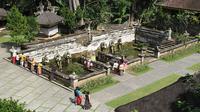The Beautiful Kintamani
Ubud, Indonesia
Trip Type: Private Sightseeing Tours
Duration: 9 hours
The trip starts with a visit to a local house compound, where every building has a purpose and therefore points in the right direction. After this you will visit Mas, a village of art with a focus on wood carvings. All the wood carving stores have an open working area where you can see the skilled craftsmen making wood products like masks, tables, chairs, or statues.
More About This Activity All Private Sightseeing Tours →
The trip starts with a visit to a local house compound, where every building has a purpose and therefore points in the right direction. After this you will visit Mas, a village of art with a focus on wood carvings. All the wood carving stores have an open working area where you can see the skilled craftsmen making wood products like masks, tables, chairs, or statues.The craftsmen work with different kind of wood such as banyan or palm. This unique village is famous for preserving their handicraft through generations. After Mas we will enter Ubud, located in central Bali among rice paddies and regarded as the cultural center of Bali. It is famous as an arts and crafts hub. Ubud is home to many local and foreign artists as well as numerous art galleries. We will continue the journey along a road to Kintamani where you will see beautiful scenes of Tegalalang’s rice terraces. The rice paddies are famous for their traditional Balinese cooperative irrigation system which, according to history, was passed on by a holy man in the 8th century. Enjoy the view of palms and rice fields in front of the great Mount Agung, the holiest and highest mountain in Bali. The absolute highlight of the tour is on top of the ridge of Mount Batur, opening up with a view of the over 4.5 miles (7.5 km) wide volcano crater. Here we will serve your lunch and you will have time to enjoy the stunning view. On your way back to the hotel, we will make a short stop at the Goa Gajah temple, the Elephant Cave. The temple was revealed to public in 1923 and its bathing place was discovered and restored only in 1954
« Go Back

